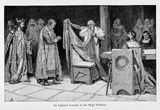Explorations in Arthurian History
The Things
|


|
- Antonine
Wall: wall 100 miles farther north than Hadrian's
Wall and about half the size. This wall extended 36 and
one-half miles from the Clyde River to the Firth of Forth
and was ordered built by the Roman emperor Antoninus Pius
in 142. The wall was 14 to 16 feet wide and about 10 feet
high. As with Hadrian's Wall, a ditch ran on the northern
side of it. A series of forts, 19 in all, were built
every two miles along the wall. Click here
and here
for more or see a detailed
map.
- Caliburn:
Arthur's magical sword according to Geoffrey of Monmouth.
Click here
for more.
- Camel
River: river in Cornwall thought to be the river by
which the Battle of Camlann was fought.
- Dozmary
Pool: pool in Cornwall said to be the Lake into which
Bedivere threw Excalibur after Arthur's trip to Avalon.
Click here
and here
and here
for more.
- Excalibur:
See Things
of the Legend.
- Hadrian's
Wall: 73-mile wall commissioned by the Roman emperor
Hadrian in 122. It ran from Wallsend on the River Tyne
west to Bowness on the Solway Firth. Hadrian's plan
called for a hill 10 feet wide and 12 feet high, complete
with a ditch on the Scottish side, a tower every
one-third mile, and a fort (milecastle) every mile.
Reality forced the Romans to build a fort every seven
miles and reduce the dimensions of the Wall to 8 feet
wide. Click here
and here
for more.
- Holy
Grail: See Things
of the Legend.
|
|

|
- Pillar
of Eliseg: memorial stone that traces the kingship of
Powys back to Vortigern, further asserting that he
married a daughter of Maximus here
and here
- Round
Table: first mentioned in Wace's Roman de
Brut. The idea was that the table, being round, would
have no head, or place of prominence. Arthur's strategy
was to reinforce the idea that none of the barons or
dukes or other nobles who sat there would be seen to
occupy places of importance greater than any other. Click
here
for more. See also Things
of the Legend.
- Siege
Perilous: seat at the Round Table where only the
Grail hero could sit without dying. Galahad
sat in it.
- Sword
in the Stone: See Things
of the Legend.
- Tristan
Stone: stone in Cornwall that is said to prove
Tristan's existence in that part of the country. The
inscription reads in part "Here lies Tristanus, son of
Dustanus." Click here
for more.
|
Back to

Explorations in Arthurian History and
Legends
Main
Page
Other





